Homemade Sourdough Bagels – With Video
Sourdough bagels are chewy, crusty and properly dense. They have an extra deep flavor thanks to the sourdough starter in the recipe. This recipe take more than 12 hours to make, but the vast majority of the time is hands-off.

I’ve said it before, I think a good bagel should have a nicely dense and chewy texture with a toothsome crust. Forget the frozen hockey pucks from the grocery store, and the bagels from chain bakeries that are way too fluffy to be a real bagel.
Homemade bagels are not hard to make and they freeze beautifully. If you set aside a little time over a weekend, you can stock up the freezer for weeks to come.
This Sourdough Bagel recipe is a variation of my popular recipe for New York Style Bagels.
If you don’t already have one, I can show you how to make a sourdough starter and how to feed a sourdough starter.
Ingredients
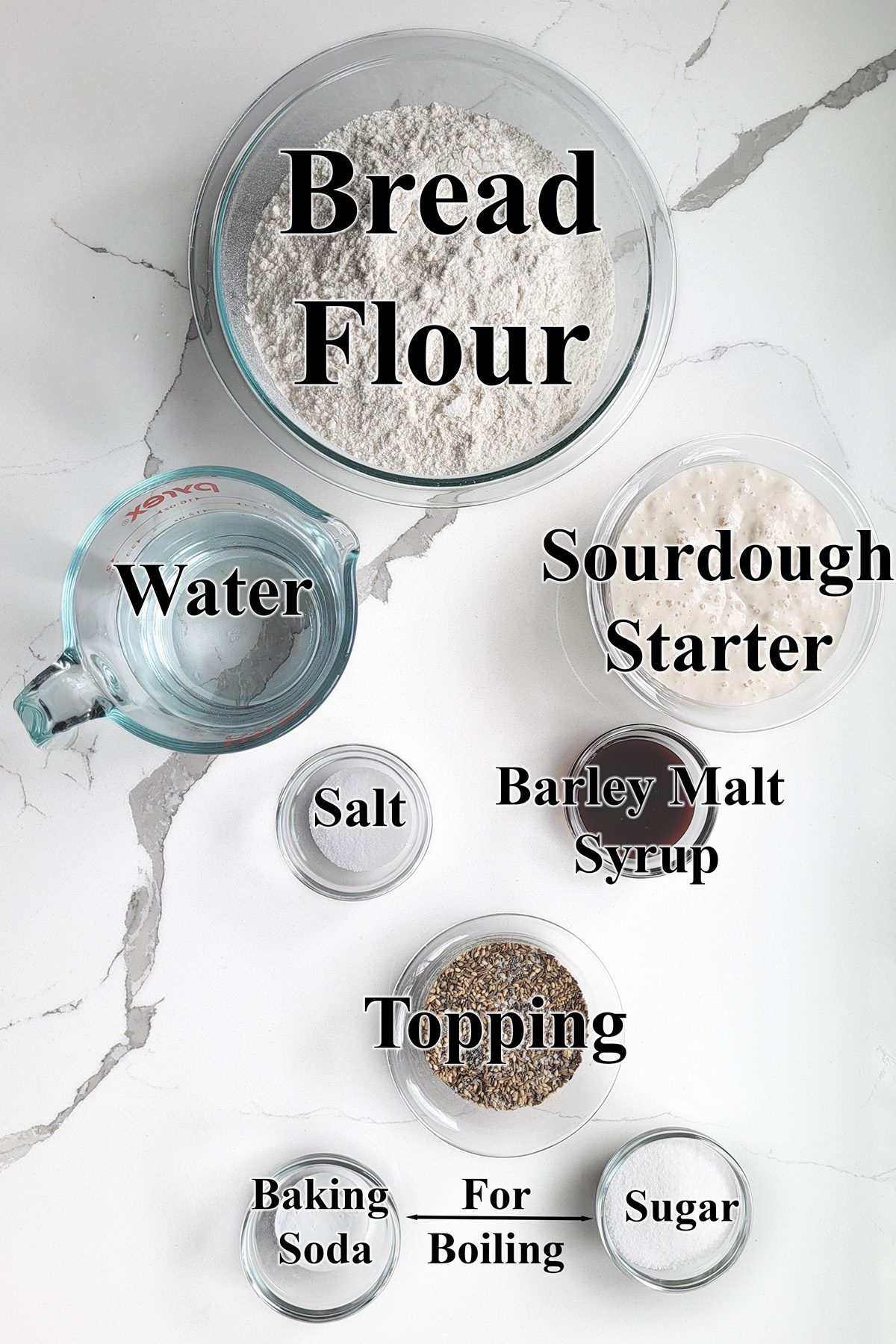
Ingredient Notes
- Bread Flour – Bagels should have a very chewy crumb from a strong gluten network in the dough. High protein bread flour develops plenty of gluten.
- Sourdough Starter – The recipe was developed using 100% hydration starter. You will need to adjust the liquid or flour in the recipe if you’re starter isn’t at 100% hydration. Your starter should be fed and active when you mix the bagel dough.
- Barley Malt Syrup – Adds a traditional slightly sweet note to the dough. You can substitute honey or a combination or honey and molasses for the barley malt syrup.
- Toppings – Leave the bagels plain or use your favorite seed for topping. You can mix seeds with salt to make your own “everything” bagel topping”. See the recipe card for details.
- Baking Soda & Sugar – For boiling the bagels. The boiling process creates the specific shiny and chewy bagel crust.
Process photos for making Sourdough Bagels
See the recipe card for detailed measurements and instructions.
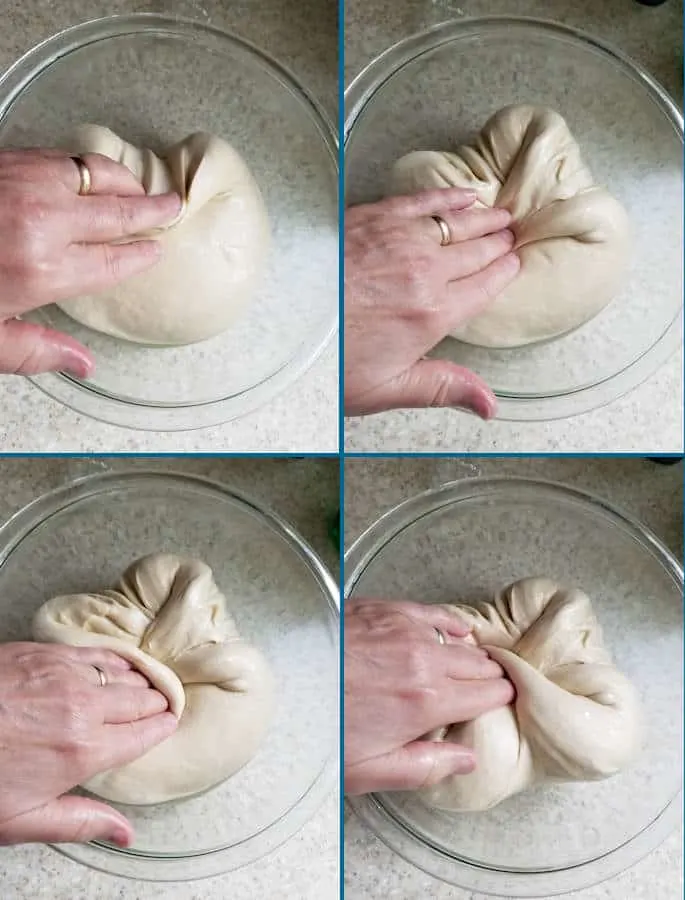
- As the dough ferments, it should be folded onto itself every hour or so to redistribute the yeast.
- Fold from each side into the middle, then flip the dough over.
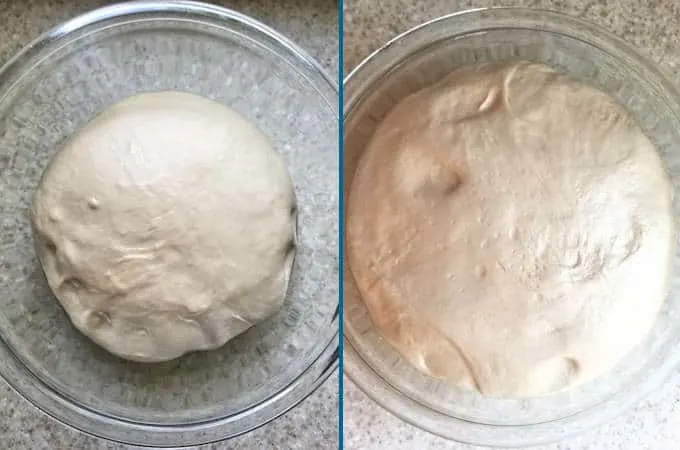
- After 30 minutes there’s not much activity in the dough (left).
- After 3 hours the dough should be active and nicely aerated (right).
- After fermentation it’s time to shape the bagels.
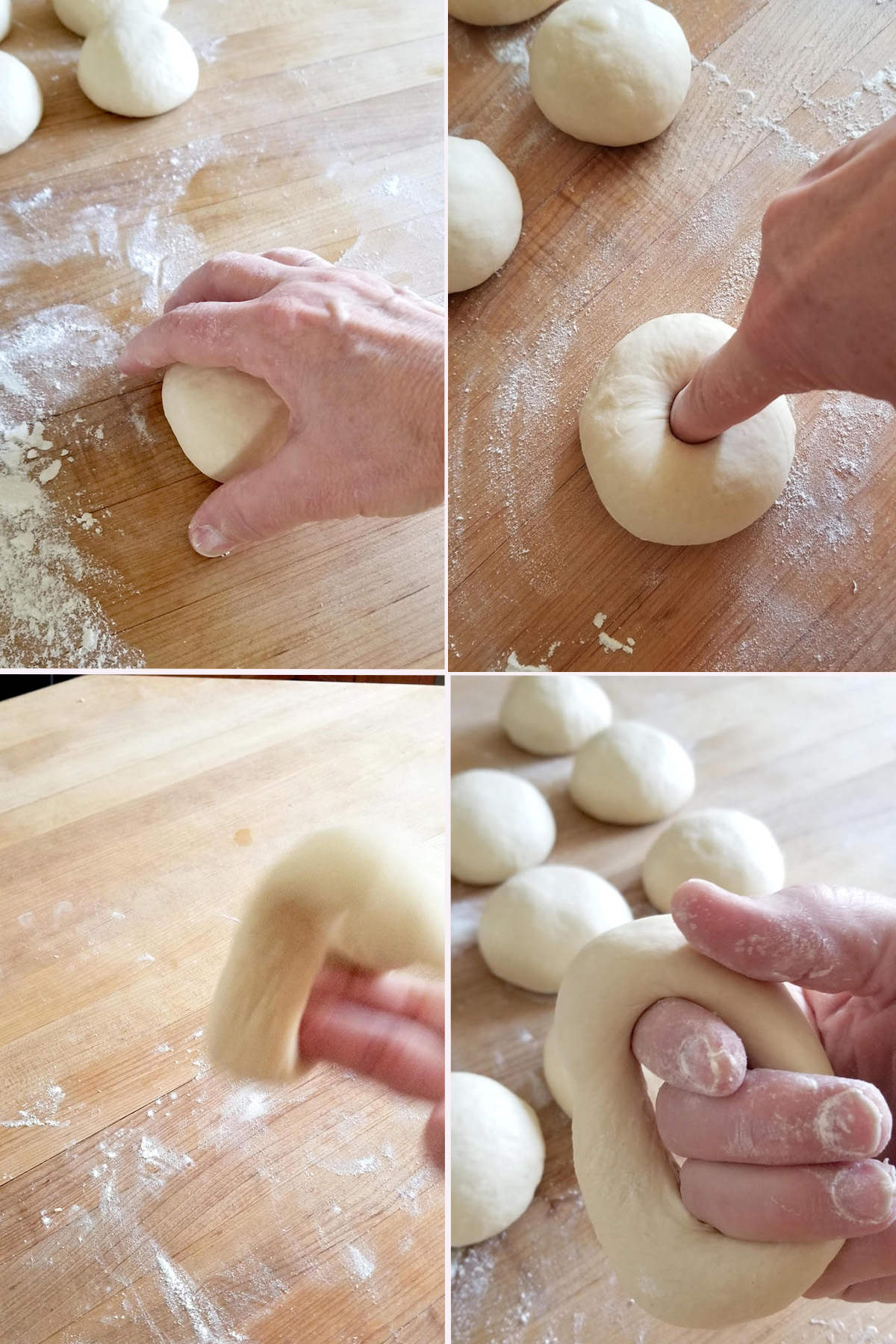
- Use a cupped hand to form the a piece of dough into a tight ball. Repeat with all the pieces of dough.
- Poke your finger all the way through the center of the ball to make a hole.
- Twirl the dough around your fingers to widen the center hole.
- Set the bagel onto the baking sheet and continue with the rest of the dough.
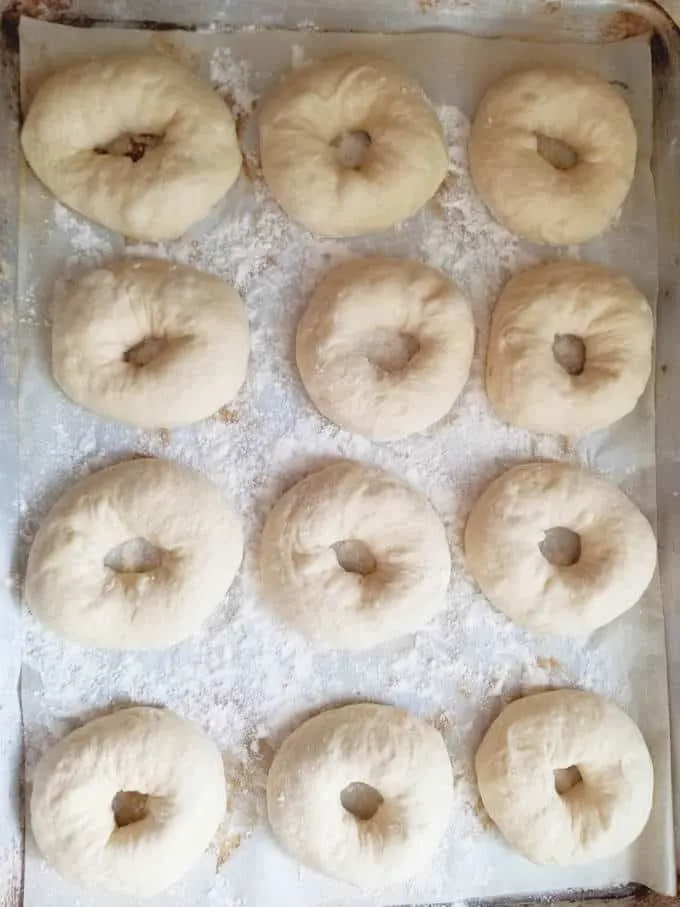
- Line the formed bagels onto a well-floured (or use cornmeal) sheet pan to prevent sticking.
- Cover the pan and place it in the refrigerator overnight.
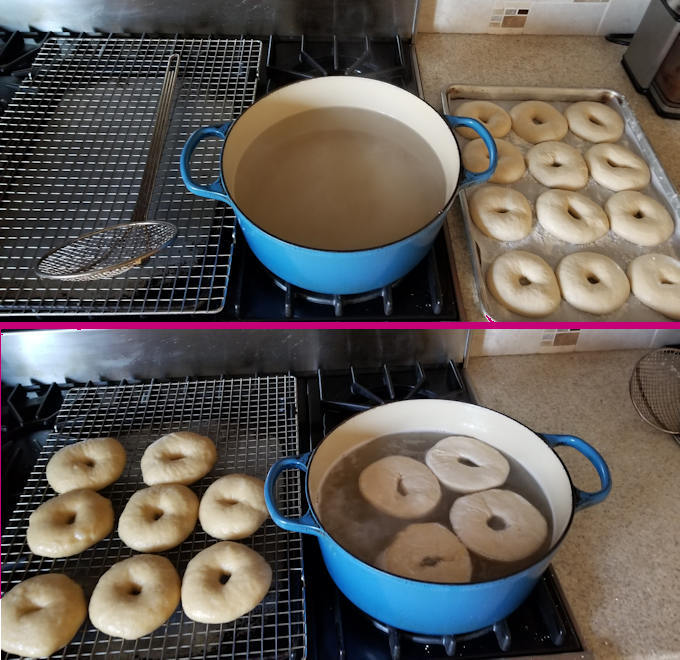
- Bring a pot of water with baking soda and sugar to a boil. Preheat the oven.
- Boil the bagels a few at a time, flipping them every thirty seconds. Boil each batch for 2 minutes.
- Transfer the bagels to a rack to drain while you finish boiling the rest of the bagels.
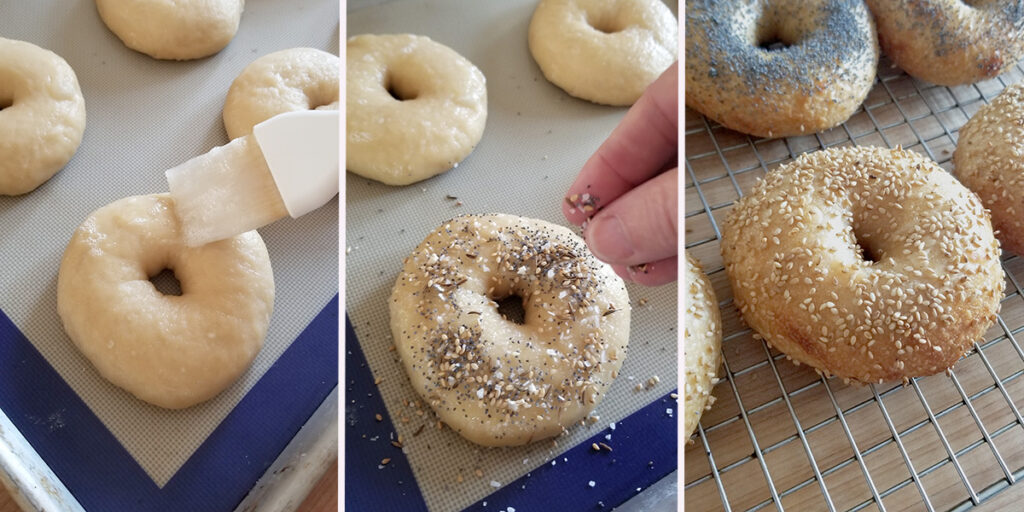
- Brush the boiled bagels with egg white.
- Sprinkle seeds or bagel topping if desired.
- Bake until the bagels are golden brown.
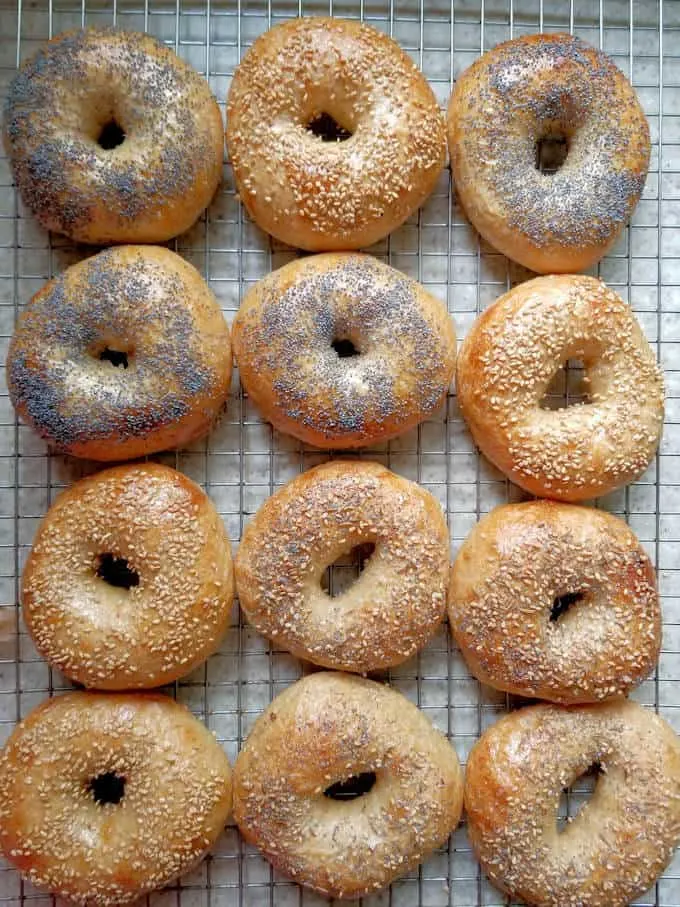
Recipe Tips
- Make sure your starter is very active and lively. I get the best results when I do two feedings in the days before making this dough. I keep several starters and use the Small Starter for this recipe because it requires two feedings before baking with it.
- To get a good bagel shape that will rise properly, you must create a tight ball of dough before making the ring. Use a cupped hand and surface friction to roll the dough into a ball. You can see how it’s done in the recipe video.
- Place the shaped bagels on sheet pan which has been sprinkled liberally with cornmeal or flour. If the bagels stick to the pan you will loose volume when transferring them to the water. I find cornmeal works best, but flour will work too.
- In the morning, take the bagels out of the fridge and leave them out until the dough comes to room temp.
- Don’t start boiling the bagels until the oven is preheated. They should go into the oven within minutes of coming out of the water.
Storage
- Bagels are best the day they are baked. For longer term storage, slice the bagels about 3/4 the way through and pack them into freezer bags.
- Previously frozen bagels are best if toasted before serving.
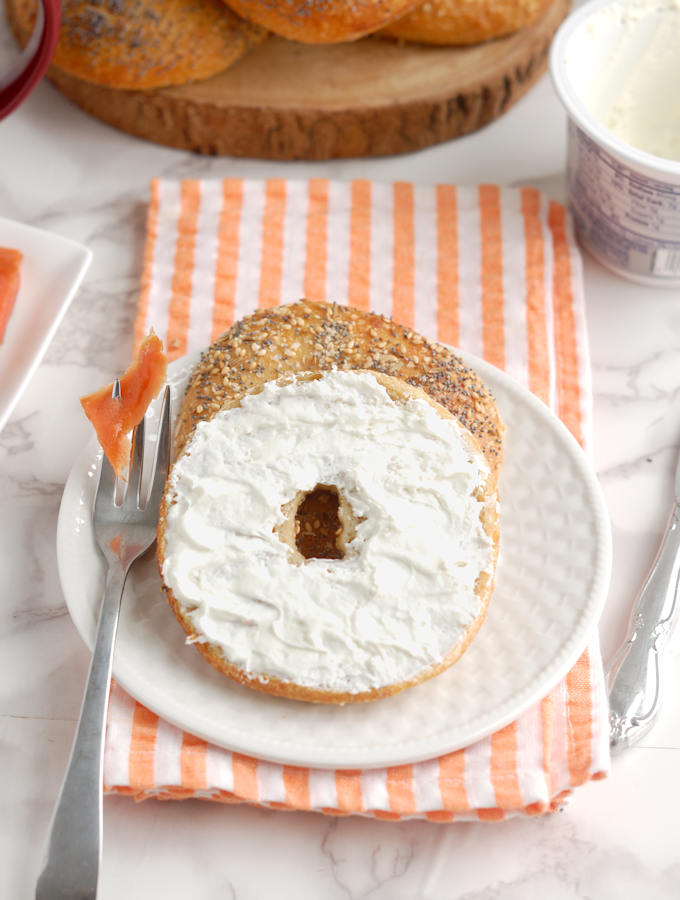
I know you hate to throw away that sourdough discard. Check out these recipes that use sourdough discard.
If you love this recipe as much as I do, please consider giving it a 5-star review.
Sourdough Bagel Recipe
Ingredients
- 8 oz active sourdough starter (1 cup (100% hydration))
- 12 oz warm water (1 ½ cups)
- 22 ½ oz bread flour (4 ½ cups, divided, see note)
- 1 ½ oz barley malt syrup (2 tablespoons (or honey + molasses))
- 1 tablespoon table salt
- 2 oz granulated sugar (¼ cup (for boiling))
- 2 teaspoons baking soda (for boiling)
- corn meal (for pan prep)
- 1 egg white (whisked lightly)
- Topping (sesame seeds, poppy seeds, caraway seeds or coarse salt)
Instructions
- Combine 8 oz active sourdough starter, 12 oz warm water and 2 cups (10 oz) of the flour in a mixing bowl. Mix to form a thick batter. Cover the bowl and set aside for 30-60 minutes.
- Add 1 ½ oz barley malt syrup and 1 tablespoon table salt. Switch to the dough hook. Add the remaining 2 ½ cups (12 ½ oz) flour and mix to combine. The dough should eventually cling to the hook and start to clear the sides of the bowl.
- Knead 5 minutes on medium speed. If working by hand, stir in as much of the flour as you can, then turn the dough out onto a lightly floured surface and knead in the remaining flour. Knead 5 minutes. Form the dough into a smooth ball.
- Put the dough into a lightly oiled bowl, turning once to coat the dough. Cover the bowl and set it aside at room temperature. After 30 minutes uncover the bowl, lift one side of the dough and fold it into the middle of the dough. Repeat with the other three sides of the dough then flip the dough over. You're basically turning the dough inside-out to redistribute the yeast. Cover the bowl and repeat the procedure every 60 minutes for a total fermentation time of about 3 hours. The dough should be lively, elastic and airy. If the dough is still sluggish give it another hour or two at room temperature.
- Line a baking pan with parchment paper then generously sprinkle the paper with cornmeal (or flour). Turn the dough out onto a lightly floured surface without kneading out the air. Divide the dough into 10 even pieces. Use a cupped hand to roll each piece into a smooth, tight ball.
- To form a bagel, poke your finger all the way through the center of a ball to make a hole. Use two fingers to gently open up the hole. Continue gently stretching to form the bagel or twirl the dough around your fingers to widen the center hole to 1 – 1½" wide.
- Place the bagel on the prepared sheet pan and continue to form the remaining bagels. The dough will probably spring back a bit so you can go back and re-stretch the holes once you're done forming all the bagels. Cover the pan with plastic wrap. If the dough and the ambient temperature is on the cooler side, leave the shaped bagels at room temperature for 30 minutes then place the pan in the refrigerator overnight. If the dough and ambient temp is warmer and the dough is quite active, place the bagels into the refrigerator without leaving them out for 30 minutes.
- In the morning take the bagels out of the refrigerator and bring them to room temperature.
- Preheat the oven to 450 °F. In a large pot combine 1 gallon of water with 2 oz granulated sugar and 2 teaspoons baking soda and bring it to a boil. Reduce the heat to keep the water at a rolling simmer. Set a cooling rack over a sheet pan or kitchen towel and place it next to the stove. Line two half-sheet pans with parchment paper or silicone baking mats and generously sprinkle with corn meal.
- Once the oven is preheated, you're ready to boil. Gently lift a bagel off the sheet pan and lower it into the water, bottom side down. Depending on the size of your pot, you can boil 3-4 bagels at a time. Boil the bagels for 30 seconds then flip them. Boil the other side for 30 seconds. Repeat the process again for a total of 2 minutes boiling time. Remove the boiled bagels from the water and set them on the cooling rack to drain.
- Place 5 of the boiled bagels on each sheet pan. You could fit them all on one pan but they may stick together as they bake.
- Brush the bagels with egg white. Add the topping(s) of your choice. To make "everything" bagels combine a tablespoon of each of sesame seeds, poppy seeds & salt with a 1/8 teaspoon garlic powder and onion powder. Bake until golden brown, about 20 minutes.
Would you like to save this recipe?
As an Amazon Associate and member of other affiliate programs, I earn from qualifying purchases.









Remade these again and double fed my starter – amazing results! Thanks so much for such a great recipe 🙂
Double feeding really seems to make a difference.
Another awesome recipe, thank you so much!!!
I have a question… if the bagels rise between the 30-50% ratio mentioned, I’m assuming I can skip leaving them overnight to rise right, and boil/bake them if risen enough on the same day?
I also agree with the double feed, however I did it in one day (morning/after lunch) which I’m thinking may have attributed to the dough turning out how it did (in a great way) – so a great tip!
You can bake them the same day, but the overnight in the fridge is for more than convenience. The long, cool rise enhances the flavor of the dough. But if you make and bake them the same stay they will still taste great. I’ve been making these every week to really nail down the process. The key is certainly to have a very active starter (double feeding works for me) and to let each stage of the process take the time needed. I’m also putting together a video so folks can see the process.
Hi Eileen,
Thanks for the great recipe. I made them today and they turned out fairly well. However I mess up a bit with the starter by adding a cup directly. In your notes you say you use 4oz starter, 4oz flour, 4oz water – do you leave this overnight? Or a few hours in the morning like a levain? Also can you elaborate on making the sponge 60 mins before? I just didn’t quite follow it.
Thank you for a great recipe looking forward to hearing your tips!
The 4 oz each of starter-water-flour is for feeding the starter. The cup of starter (8oz) does go directly into the bagel dough. The 60 minutes of the sponge is to get a head start on developing gluten.
I have made these three times now and love the flavour but they end up as pancakes every time, first time as the clingfilm got stuck, second time as the first rise was too long, and the third time, well, just because i touched them when they were going into the water and they went flat. So i think i’m ready to give up and try something that doesn’t involve having to do stuff with the bread after the final rise. They were also difficult to get off the baking sheet so even with large amount of flour they didn’t release that easily and ended up with a sticky flour layer on the bottom. I do so want to love them but they just don’t seem to work for me. 🙁
Hi Marie. Sorry you’re having trouble. I think the sticking point (no pun intended) for many people is the step where they have to transfer the bagels to the water. If the bagels stick to each other or the tray they can loose some volume. I make these bagels almost every week and I’ll tell you what has worked best for me. First and foremost, I find that if my starter is a little sluggish the whole process is more difficult. Last week I gave my starter two feedings before mixing the dough and the bagels turned out beautifully. I think the condition of your starter can make a huge difference. Also, I have been dusting the pan with cornmeal rather than flour lately. Both work, but the cornmeal seems to make the unbaked bagels stick less. I’m updating the post with some new tips to help folks that are having trouble.
Hi, I am new to using a starter but mine is ready to use and I’d really love to try these bagels. I don’t have a stand mixer. Would you have any advice regarding what I’m looking for when mixing and kneading? Thanks
Without a mixer you’ll have to mix in as much of the flour as you can my hand. Turn the dough out onto a well-floured surface to do a good 5-7 minutes of hand kneading. The dough is fairly wet so make sure to keep your hands and the dough floured. Then proceed with the recipe as written.
Hi Eileen,
Thank you for your recipe, my bagels didn’t rise as much as yours but they taste great and have a really good chewy bagel texture and flavour! I did have to add extra flour as did someone else in the UK to get in the dough the right consistency. These are amazing and I will definitely be making them regularly!
Just this morning I finished shooting a video of this recipe. It will be on the website in a few days. You can watch the video to see how the dough looks, etc.
These came out amazing! Definitely exceeded my expectations as a beginner with sourdough. The dough was very tough but smooth and took at least 10 mins to knead by hand. My starter isn’t super strong so I don’t trust it in the fridge, and my house is on the cool side, so I left these wrapped in plastic overnight on the counter and they rose just enough. We made garlic salt and cheese bagels, I will definitely double the recipe next time!
Garlic & Cheese, Yumm!